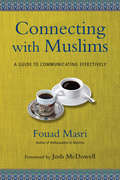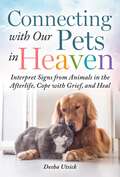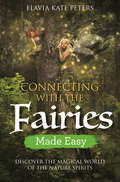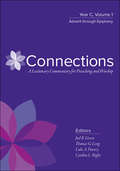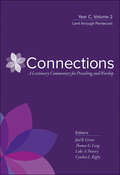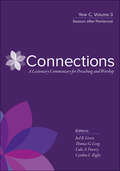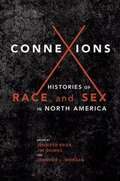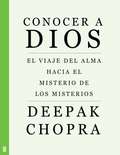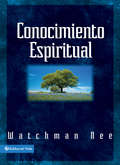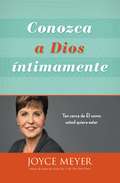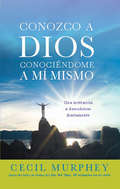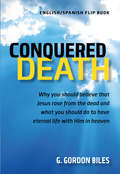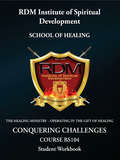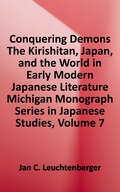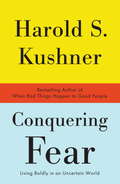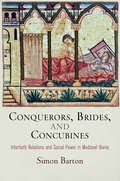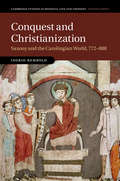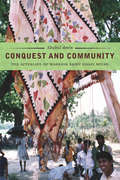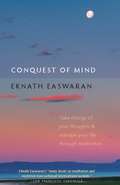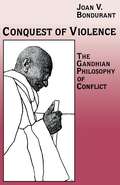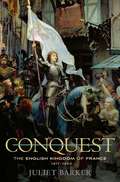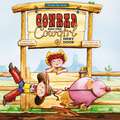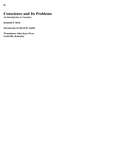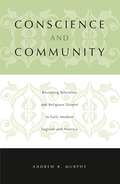- Table View
- List View
Connecting with Our Pets in Heaven: Interpret Signs from Animals in the Afterlife, Cope with Grief, and Heal
by Desha UtsickAn A to Z guide of signs and symbols that show your best friends never really left your side.In many cases, we don&’t choose pets to welcome into our family; they choose us. Or some divine intervention seems to bring us together. That mysterious but amazing bond is not broken when an animal leaves our realm. Our pets continue to reach out to us in loving, encouraging, even instructing ways after they cross the rainbow bridge.This beautiful book, complete with inspiring photos, will share the many ways pets speak to us through signs in nature (cardinals, rainbows, clouds), patterns that pop up in our daily lives (from smudges on glass to pawprints on a path), familiar pet sounds (jangling tags or the voice of one pet through another), orbs, dreams, and more. Organized in an A-to-Z format by pet sign, you&’re sure to find a connection to pets who have been part of your family. Heart-warming personal stories from the author and other pet lovers share the promise that our animals and their love remain in our lives forever.
Connecting with the Fairies Made Easy: Discover the Magical World of the Nature Spirits
by Flavia Kate PetersAn introductory book on connecting with the mystical, magical world of the Fairies.In parallel with our world is another ancient and mystical realm which holds the answers to the imbalance we see in our modern, fractured society. This is the realm of the Fairies. In Connecting with the Fairies Made Easy, readers who feel a deep bond with the natural world will learn to reconnect with the old ways of the Fairies to restore balance and harmony in their lives. Fairies are nature spirits and the guardian angels of the natural world. Flavia Kate Peters - known as the Faery Seer -has been communing with them since childhood and is a wisdom keeper of the fairy realm. In this book, she shares where to find fairies and how to communicate with them through spells, meditations, invocations and magical ceremonies. She leads the reader through unique exercises such as Fire Scrying, Moon Bathing and Fairy Circling. Having communicated with many different kinds of fairies, she explains the differences between them - from gnomes and sylphs to salamanders and undines - and what their roles are in the natural world. For those new to the Fairy realm, this book is an essential resource to help them reopen the gates to the mystical world of the Fairies.This title was previously published within the Hay House Basics series.
Connections: Year C, Volume 1, Advent through Epiphany
by Thomas Long Joel Green Luke Powery Cynthia RigbyDesigned to empower preachers as they lead their congregations to connect their lives to Scripture, Connections features a broad set of interpretive tools that provide commentary and worship aids on the Revised Common Lectionary. For each worship day within the three-year lectionary cycle, the commentaries in Connections link the individual lection reading with Scripture as a whole as well as to the larger world. In addition, Connections places each Psalm reading in conversation with the other lections for the day to highlight the themes of the liturgical season. Finally, sidebars offer additional connections to Scripture for each Sunday or worship day.
Connections: Year C, Volume 2, Lent through Pentecost
by Thomas Long Joel Green Luke Powery Cynthia RigbyDesigned to empower preachers as they lead their congregations to connect their lives to Scripture, Connections features a broad set of interpretive tools that provide commentary and worship aids on the Revised Common Lectionary. For each worship day within the three-year lectionary cycle, the commentaries in Connections link the individual lection reading with Scripture as a whole as well as to the larger world.
Connections: Year C, Volume 3, Season after Pentecost
by Thomas Long Joel Green Luke Powery Cynthia RigbyDesigned to empower preachers as they lead their congregations to connect their lives to Scripture, Connections features a broad set of interpretive tools that provide commentary and worship aids on the Revised Common Lectionary. For each worship day within the three-year lectionary cycle, the commentaries in Connections link the individual lection reading with Scripture as a whole as well as to the larger world. In addition, Connections places each Psalm reading in conversation with the other lections for the day to highlight the themes of the liturgical season. Finally, sidebars offer additional connections to Scripture for each Sunday or worship day.
Connexions: Histories of Race and Sex in North America
by Jennifer Brier Jim Downs Jennifer L MorganConnexions investigates the ways in which race and sex intersect, overlap, and inform each other in United States history. An expert team of editors curates thought-provoking articles that explore how to view the American past through the lens of race and sexuality studies. Chapters range from the prerevolutionary era to today to grapple with an array of captivating issues: how descriptions of bodies shaped colonial Americans' understandings of race and sex; same-sex sexual desire and violence within slavery; whiteness in gay and lesbian history; college women's agitation against heterosexual norms in the 1940s and 1950s; the ways society used sexualized bodies to sculpt ideas of race and racial beauty; how Mexican silent film icon Ramon Navarro masked his homosexuality with his racial identity; and sexual representation in mid-twentieth-century black print pop culture. The result is both an enlightening foray into ignored areas and an elucidation of new perspectives that challenge us to reevaluate what we "know" of our own history. Contributors: Sharon Block, Susan K. Cahn, Stephanie M. H. Camp, J. B. Carter, Ernesto Chávez, Brian Connolly, Jim Downs, Marisa J. Fuentes, Leisa D. Meyer, Wanda S. Pillow, Marc Stein, and Deborah Gray White.
Conocer a Dios
by Deepak ChopraDios es nuestro más elevado instinto de conocernos a nosotros mismos.»DEEPAK CHOPRA En esta obra Deepak Chopra alcanza su máxima expresión, una perfecta mezcla entre filosofía y ciencia, aplicada al más importante de todos los temas. Este libro constituye una espectacular y perdurable contribución a la búsqueda de Dios.«Felicito al doctor Deepak Chopra por este libro maravilloso que está al alcance de muchísimos lectores, y que toca el tema de la espiritualidad con una visión científica. Estoy totalmente de acuerdo con él en que: si queremos cambiar el mundo, hemos de empezar por cambiarnos a nosotros mismos. Éste es el mensaje que yo siempre he transmitido.»DALAI LAMA« Conocer a Dios debería estar en la mesilla de noche de todo aquel que busca la Verdad y el Espíritu. Más aún, debería llevarlo siempre consigo mientras realiza el viaje de su alma.»SHIRLEY MACLAINE, autora de El camino «Deepak Chopra continúa guiándonos, cada vez más profundamente, a través de los misterios y los gozos de la verdadera espiritualidad.» JAMES REDFIELD,autor de La Décima Revelación y La Undécima Revelación«Una mente brillante ha creado un libro que debería ser leído porcreyentes y no creyentes. Se trata de un tesoro de conocimiento que todos deberíamos abrir y explorar, independientemente de nuestras creencias o de nuestra fe. El conocimiento que nos presenta puede cambiar nuestras vidas.»DR. BERNIE S. SIEGEL, autor de Paz, amor y auto curación
Conocer a Dios: El Viaje Hacia El Misterio De Los Misterios
by Deepak ChopraEl viaje del alma hacia el misterio de los misterios guiado por el lider espiritual Deepak Chopra. "Dios es nuestro más elevado instinto de conocernos a nosotros mismos." Deepak Chopra. En esta obra Deepak Chopra alcanza su máxima expresión, una perfecta mezcla entre filosofía y ciencia, aplicada al más importante de todos los temas. Este libro constituye una espectacular y perdurable contribución a la búsqueda de Dios. "Felicito al doctor Deepak Chopra por este libro maravilloso que está al alcance de muchísimos lectores, y que toca el tema de la espiritualidad con una visión científica. Estoy totalmente de acuerdo con él en que: si queremos cambiar el mundo, hemos de empezar por cambiarnos a nosotros mismos. Éste es el mensaje que yo siempre he transmitido." Dalai Lama. "Conocer a Dios debería estar en la mesilla de noche de todo aquel que busca la Verdad y el Espíritu. Más aún, debería llevarlo siempre consigo mientras realiza el viaje de su alma." Shirley Maclaine, autora de El camino. "Deepak Chopra continúa guiándonos, cada vez más profundamente, a través de los misterios y los gozos de la verdadera espiritualidad." James Redfield, autor de La Décima Revelación y La Undécima Revelación. "Una mente brillante ha creado un libro que debería ser leído por creyentes y no creyentes. Se trata de un tesoro de conocimiento que todos deberíamos abrir y explorar, independientemente de nuestras creencias o de nuestra fe. El conocimiento que nos presenta puede cambiar nuestras vidas." Dr. Bernie S. Siegel, autor de Paz, amor y autocuración.
Conocimiento Espiritual
by Watchman NeeEsta obra nos ayuda a desarrollar el conocimiento espiritual. Expone en forma amena el verdadero conocimiento de Dios y de nosotros mismos, así como la relación de tal conocimiento con la renovación de la mente.
Conozca a Dios íntimamente: Tan cerca de Él como usted quiera estar
by Joyce MeyerSi usted está en búsqueda de Dios, o si es un creyente que siente que le falta algo, Joyce Meyer, la autora de éxitos de ventas número 1 del New York Times, quiere mostrarle cómo experimentar el gozo profundo que proviene de una relación verdaderamente íntima con Dios.Utilizando la Escritura y ejemplos poderosos de la vida real, Joyce revela maneras prácticas donde usted puede crecer más cerca de Dios a través de su relación personal con Él. Para lograrlo, ella ofrece una imagen clara de cuatro niveles de intimidad que usted puede experimentar. En cada nivel, desde reconocer la presencia de Dios hasta dejar que su amor transforme su vida por completo, Joyce muestra cómo moverse, paso a paso, más cerca de Dios y descubrir todo lo que Él tiene para usted.¿Está tan cerca de Dios como quiere estar? ¿Quiere saber qué tan profundo puede llegar en su relación con Él? En CONOZCA A DIOS ÍNTIMAMENTE, Joyce Meyer le da las claves para tener una verdadera intimidad con Él todos los días, en cada área de su vida. Él está esperando; la decisión es suya. ¿Abrirá usted la puerta?
Conozco a Dios conociéndome a mi mismo: Una invitación a descubrirse diariamente
by Cecil MurpheyCrezca en la gracia y el conocimiento de nuestro Señor. Se ha dicho que no podemos conocernos a nosotros mismos a menos que conozcamos a Dios. Lo opuesto también es cierto: No podemos conocer a Dios íntimamente sin antes autoconocernos. Estos dos anhelos - el deseo de Dios y el de plenitud interior - están inextricablemente entrelazados. El autor de éxitos de ventas, Cecil Murphey ha cautivado a millones de lectores por su estilo lírico e incomparale narrativa. No obstante, entre bastidores de su exitosa carrera, Murphey está en búsqueda de Dios y de sí mismo. De esta incesante búsqueda nace Conozco a Dios, conociéndome a mí mismo, una colección de meditaciones presentadas en el estilo único que caracteriza al autor. A medida que reflexiona y viaja por este inolvidable libro creará más conciencia de la presencia de Dios y recibirá una vida interna renovada.
Conquered Death/Conquistó La Muerte: Why You Should Believe That Jesus Rose From the Dead and What You Should Do to Have Eternal Life With Him in Heaven
by G. Gordon BilesAll of us know someone who isn&’t a Christian. Many of us have relatives and friends who don&’t believe in Jesus. Their eternal security weighs on our hearts. We want them all to know Jesus and His assurance of eternal life. You may wonder how you can reach them with the gospel—or even how you could personally lead them to Christ. One way is to share this mini-book with them. G. Gordon Biles wrote it for people, like your relatives and friends, who think there is no life after death. He includes historical texts and Scripture passages presented in such a way as to prove that Jesus rose from the dead and came to save the lost. Also included are simple directions on how to become a Christian and how to pray. Uniquely, Conquered Death is also written in two languages, English and Spanish. Is there life after death? Yes! Conquered Death will help you convince those you love to spend their life after death with Jesus.
Conquering Challenges Course: BS104 Student Workbook
by Robin DinnanauthThis Course discusses common traditions of men concerning healing. A Biblical response to each tradition is presented since the best remedy against error is not silence, but proclamation of the truth of God's Word. As we remove traditions and objections concerning healing, we remove barriers blocking divine healing from occurring. The Psalmist David indicated that although he previously declared his own ways he now desired to learn the ways of God..
Conquering Demons: The Kirishitan, Japan, and the World in Early Modern Japanese Literature (Michigan Monograph Series In Japanese Studies)
by Jan C. LeuchtenbergerThese sensational fictional accounts of a near conquest of Japan by a kind of mythical Kirishitan, who used money and magic to gain converts in their attempt to take over Japan, are studied in the context of the publication trends of the time they were produced, as well as of the cultural and political attitudes toward Christianity that prevailed when they were written. Leuchtenberger also analyzes the representations of Japan and the Kirishitan that appear in these texts in the context of contemporary discourses on the world and Japan's place in it. New maps and information brought by the missionaries and traders to Japan reflected a world that looked very different from the traditional Sino-centric one. These anti-Kirishitan popular narratives meet the challenge of this new world by expelling it and reasserting the conventional three-realms world order, in which Japan plays an influential role. This is done most obviously in the expulsion of the Kirishitan that is narrated in the texts, but it is also achieved on another level by the representation of the Kirishitan as uncouth and very common villains. Conquering Demons features a new look at anti-Kirishitan works from a literary perspective, examining them in the context of developments in the publishing industry and in the broader discourses on Japan and many Others in the world. It is of interest most broadly to scholars and teachers of Japanese history and literature, but also to those dealing with questions of identity and Othering, issues of "mapping" Japan and the world, and the role of manuscript culture in Edo-period literature. The translations provide an entertaining and relatively rare look at some Japanese representations of Westerners and would be useful in undergraduate classes on Japanese history, culture, and literature.
Conquering Fear: Living Boldly in an Uncertain World
by Harold S. KushnerFrom the bestselling author of "When Bad Things Happen to Good People" comes an illuminating look at fear--and specific steps one can do to overcome it.
Conquerors, Brides, and Concubines: Interfaith Relations and Social Power in Medieval Iberia (The Middle Ages Series)
by Simon BartonConquerors, Brides, and Concubines investigates the political and cultural significance of marriages and other sexual encounters between Christians and Muslims in the Iberian Peninsula, from the Islamic conquest in the early eighth century to the end of Muslim rule in 1492. Interfaith liaisons carried powerful resonances, as such unions could function as a tool of diplomacy, the catalyst for conversion, or potent psychological propaganda. Examining a wide range of source material including legal documents, historical narratives, polemical and hagiographic works, poetry, music, and visual art, Simon Barton presents a nuanced reading of the ways interfaith couplings were perceived, tolerated, or feared, depending upon the precise political and social contexts in which they occurred.Religious boundaries in the Peninsula were complex and actively policed, often shaped by an overriding fear of excessive social interaction or assimilation of the three faiths that coexisted within the region. Barton traces the protective cultural, legal, and mental boundaries that the rival faiths of Iberia erected, and the processes by which women, as legitimate wives or slave concubines, physically traversed those borders. Through a close examination of the realities and the imagination of interfaith relations, Conquerors, Brides, and Concubines highlights the extent to which sex, power, and identity were closely bound up with one another.
Conquest and Christianization: Saxony and the Carolingian World, 772–888 (Cambridge Studies in Medieval Life and Thought Fourth Series)
by Ingrid RemboldFollowing its violent conquest by Charlemagne (772–804), Saxony became both a Christian and a Carolingian region. This book sets out to re-evaluate the political integration and Christianization of Saxony and to show how the success of this transformation has important implications for how we view governance, the institutional church, and Christian communities in the early Middle Ages. A burgeoning array of Carolingian regional studies are pulled together to offer a new synthesis of the history of Saxony in the Carolingian Empire and to undercut the narrative of top-down Christianization with a more grassroots model that highlights the potential for diversity within Carolingian Christianity. This book is a comprehensive and accessible account which will provide students with a fresh view of the incorporation of Saxony into the Carolingian world. Offers a new synthesis of the history of Saxony in the Carolingian period. Suggests a more grassroots model of Christianization. Accessible to students and non-specialist readers.
Conquest and Community: The Afterlife of Warrior Saint Ghazi Miyan
by Shahid AminFew topics in South Asian history are as contentious as that of the Turkic conquest of the Indian subcontinent that began in the twelfth century and led to a long period of Muslim rule. How is a historian supposed to write honestly about the bloody history of the conquest without falling into communitarian traps? Conquest and Community is Shahid Amin's answer. Covering more than eight hundred years of history, the book centers on the enduringly popular saint Ghazi Miyan, a youthful soldier of Islam whose shrines are found all over India. Amin details the warrior saint’s legendary exploits, then tracks the many ways he has been commemorated in the centuries since. The intriguing stories, ballads, and proverbs that grew up around Ghazi Miyan were, Amin shows, a way of domesticating the conquest—recognizing past conflicts and differences but nevertheless bringing diverse groups together into a community of devotees. What seems at first glance to be the story of one mythical figure becomes an allegory for the history of Hindu-Muslim relations over an astonishingly long period of time, and a timely contribution to current political and historical debates.
Conquest of Mind
by Eknath EaswaranGetting caught in unwanted thoughts and emotions can feel like an inevitable part of life. But Easwaran, who taught meditation for nearly 40 years, shows a way to break free.Just as a fitness routine can result in a strong, supple body, spiritual disciplines can shape a secure personality and a resilient, loving mind.And opportunities to grow stronger spiritually arise not only during meditation but throughout the day. Working with difficult colleagues, going out to eat, and responding to a child's needs are all occasions to try out different, wiser choices.With humor and empathy, Easwaran places timeless teachings from the Buddha and other mystics into contemporary scenes - watching a juggler on the street, taking a tennis lesson, going to the theater. Training the mind is life's biggest adventure, one that brings deepening relationships, increasing vitality, and a greater sense of purpose.
Conquest of Violence: The Gandhian Philosophy of Conflict (Princeton Paperbacks)
by Joan Valerie BondurantWhen Mahatma Gandhi died in 1948 by an assassin's bullet, the most potent legacy he left to the world was the technique of satyagraha (literally, holding on to the Truth). His "experiments with Truth" were far from complete at the time of his death, but he had developed a new technique for effecting social and political change through the constructive conduct of conflict: Gandhian satyagraha had become eminently more than "passive resistance" or "civil disobedience." By relating what Gandhi said to what he did and by examining instances of satyagraha led by others, this book abstracts from the Indian experiments those essential elements that constitute the Gandhian technique. It explores, in terms familiar to the Western reader, its distinguishing characteristics and its far-reaching implications for social and political philosophy.
Conquest: The English Kingdom of France 1417-1450
by Juliet BarkerFor thirty dramatic years, England ruled a great swath of France at the point of the swordâan all-but-forgotten episode in the Hundred Yearsâ War that Juliet Barker brings to vivid life in Conquest. Following Agincourt, Henry Vâs second invasion of France in 1417 launched a campaign that would place the crown of France on an English head. Buoyed by conquest, the English army seemed invincible. By the time of Henryâs premature death in 1422, nearly all of northern France lay in his hands and the Valois heir to the throne had been disinherited. Only the appearance of a visionary peasant girl who claimed divine guidance, Joan of Arc, was able to halt the English advance, but not for long. Just six months after her death, Henryâs young son was crowned in Paris as the firstâand lastâEnglish king of France. Henry VIâs kingdom endured for twenty years, but when he came of age he was not the leader his father had been. The dauphin whom Joan had crowned Charles VII would finally drive the English out of France. Barker recounts these stirring eventsâthe epic battles and sieges, plots and betrayalsâthrough a kaleidoscope of characters from John Talbot, the âEnglish Achilles,â and John, duke of Bedford, regent of France, to brutal mercenaries, opportunistic freebooters, resourceful spies, and lovers torn apart by the conflict.
Conrad and the Cowgirl Next Door (The Next Door Series)
by Denette FretzREAD and HEAR edition: Conrad and the Cowgirl Next Door, the second book in &“The Next Door Series,&” tells the tale of a young boy whose biggest challenge during his summer of cowboy training is the know-it-all-cowgirl next door. Conrad can&’t wait to start cowboy training at his Uncle Clint&’s ranch, but he soon realizes he has a lot to learn – including don&’t squat with spurs on and never wave your red sweatshirt at a bull. To make matter worse, Imogene Louise Lathrup, the cowgirl next door, shows up and is all too happy to point out Conrad&’s shortcomings. In the follow-up to their smash hit Pirates on the Farm, author Denette Fretz and illustrator Gene Barretta team up once again to tell a humorous tale about loving your neighbor.Kids will enjoy the cowboy terminology in the back of the book, while parents will appreciate the letter from the author that includes questions that encourage discussion about what loving your neighbor really means.
Conscience And Its Problem: An Introduction To Casuistry (Library Of Theological Ethics)
by Kenneth E. KirkThis book, originally published in 1927, has proven to be one of the most important and influential books in the field of ethics in the twentieth century. It remains a pertinent, original, and insightful work--a landmark statement of modern casuistry. The Library of Theological Ethics series focuses on what it means to think theologically and ethically. It presents a selection of important and otherwise unavailable texts in easily accessible form. Volumes in this series will enable sustained dialogue with predecessors though reflection on classic works in the field.
Conscience and Community: Revisiting Toleration and Religious Dissent in Early Modern England and America (G - Reference, Information and Interdisciplinary Subjects)
by Andrew R. MurphyReligious toleration appears near the top of any short list of core liberal democratic values. Theorists from John Locke to John Rawls emphasize important interconnections between the principles of toleration, constitutional government, and the rule of law. Conscience and Community revisits the historical emergence of religious liberty in the Anglo-American tradition, looking deeper than the traditional emergence of toleration to find not a series of self-evident or logically connected expansions but instead a far more complex evolution. Murphy argues that contemporary liberal theorists have misunderstood and misconstrued the actual historical development of toleration in theory and practice. Murphy approaches the concept through three "myths" about religious toleration: that it was opposed only by ignorant, narrow-minded persecutors; that it was achieved by skeptical Enlightenment rationalists; and that tolerationist arguments generalize easily from religion to issues such as gender, race, ethnicity, and sexuality, providing a basis for identity politics.
